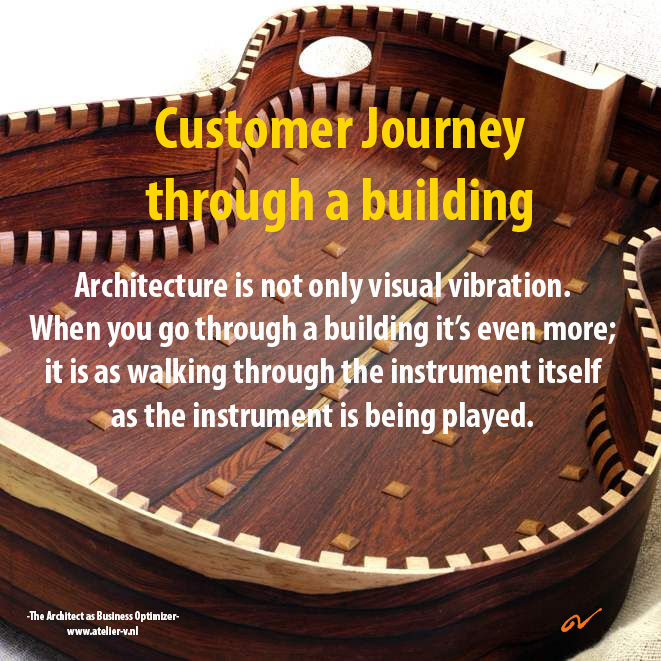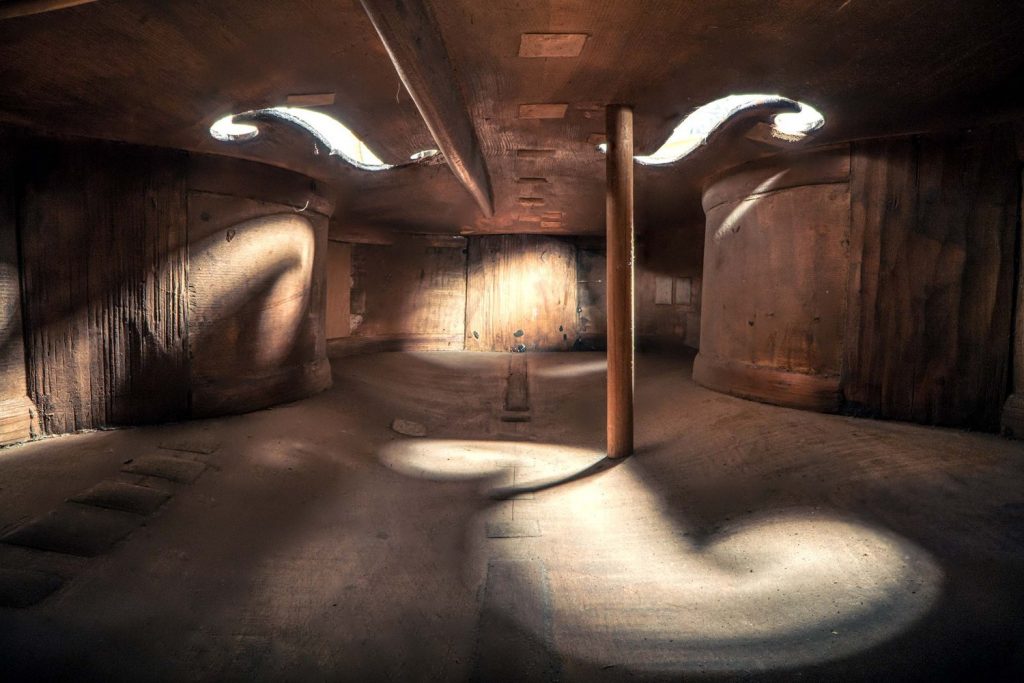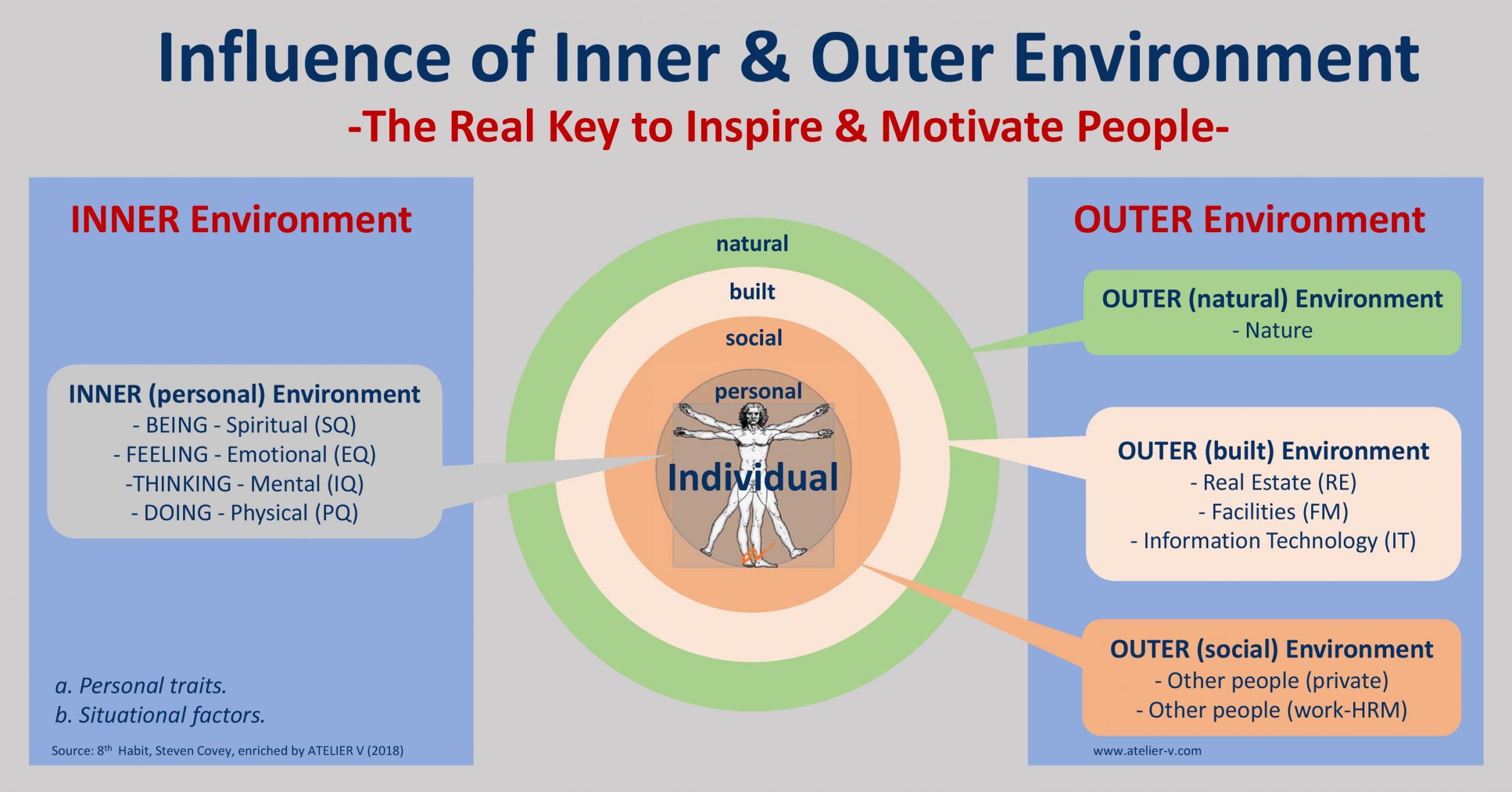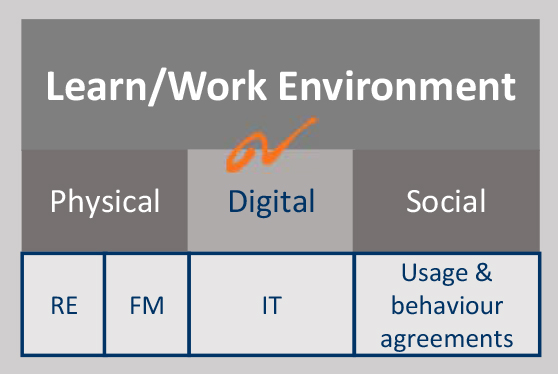
‘Architecture is a Symphony of Form’ is an exploration odyssey about REAL ESTATE and the REAL STATE of people. The interface and interaction between the state of the outer environment (physical, digital, social) and the health and well-being of the inner environment (body, mind, heart, spirit) of people.
Linking our outer environment with our inner one creates coherence in the work/life balance. The physical, digital, and social parts of the outer environment as well as the body, mind, heart, and spirit of the inner environment are like the role of each note in a symphony. That resonates with human beings.
Buildings have a major impact on the people who use them. Therefore, also on the results of the processes in which these people are involved as on their personal health, well-being and consciousness.
All physical matter in our universe is vibrating and emanates a field of energy that can be measured and influenced. Robert Lawlor describes in his book Sacred Geometry matter as ‘geometrized light energy’, i.e. energy stabilized and held in a form by geometry. Whenever anything vibrates it creates a geometric pattern. Vibrations affect matter and thus also living beings.
For an example of how vibrations affect matter see the video about Cymatics. The way something vibrates is a reflection of the whole shape. The whole is more than the sum of its parts. Just like sound can create order from chaos, so does architectural form create orderliness. Geometry guides energy into matter. Without geometry, the physical universe could not exist.
In a situation you have only three possibilities; accept it, change it or leave it. The same could be said about the entrainment effect of vibrations. Brainwave entrainment refers to the brain’s electrical response to rhythmic sensory stimulation, such as pulses of sound or light.
For example, when you hear music or are in an environment, you either “move with it”, change it, or leave it. You cannot ignore the music/vibration. Vibration always tries to interact with another vibration.
One of the lost secrets of ancient wisdom teachings is that geometry is vibration. Geometry is a visual representation, a structural manifestation of vibration. “Music is the light we cannot see, Light is the Music we cannot hear.” (Robert Edward Grant). “Geometry is the music we hear with our eyes.” (René Stevens).
The German writer Johan Wolfgang von Goethe called Architecture ‘frozen music’, I prefer to call it ‘Symphony of Form’, a symbiotic resonance between architecture and its occupants to create (more) added value.
“Architecture is a Symphony of Form,
a symbiotic resonance between architecture and its occupants to create (more) added value.”
(René Stevens)
According to Louis Turenne shapes such as pyramids, spheres and squares act as resonators for telluric and cosmic forces. Just as the shape of a violin improves the quality of tone. The shape provides a resonant cavity for crystalline structures such as materials and biological life including humans. When we interact with geometric shapes, there is an instantaneous transfer of energy into our very being. This creates a resonance effect, a two-way exchange of information.
The geometry of a space influences the way atoms and air interact and move within a given area just as a vortex in water behaves differently according to the shape through which it flows. Geometrical shapes do have a corresponding effect on the human body’s own geometry. Thus rooms of different shapes generate different energetic environments that are capable of influencing the senses.
Instruments in sync

Geometry is a visual representation and structural manifestation of vibrations made possible by light as sound is an audible manifestation of vibration. By ‘tuning’ a building, a musical symphony is created instead of a cacophony of sound. This creates a built environment where people and organisations can recharge themselves to create value together.
Architecture is not only visual vibration. When you go through a building it’s even more; it is as walking through the instrument itself as the instrument is being played. Architecture creates buildings as giant resonating musical instruments.
When an orchestra performs a musical symphony, it is important that all instruments are tuned, in balance, and playing with the right intensity and duration. For a high-level performance, everything must be in sync.
For the functioning of our learn/work environment, it is equally important that all building components, like shapes, parts, materials and colours, including the relationship with nature (E.g. earth’s energy radiation, geopathic stress, climate, seasons, vegetation, bodies of water) are in sync. They all contribute to the desired harmonious balancing environment that supports people’s health and well-being and their functioning within a building.
The perception of being satisfied with the performance of the building depends upon our interaction with the environment and the people in it, as well as our physical and mental constitution.
Affect mood
Just as music affects our mood, buildings do too. We have all experienced music that can touch you and make you feel like dancing, or getting into a romantic or meditative state, or even a melancholic state. Even though we may not yet have the tools to fully measure how architecture affects the health, well-being and consciousness of the people inside a building, we know intuitively that it makes sense.
A growing body of research demonstrates that it is not the objective environmental conditions, but the subjective interpretation of them, that affects the well-being and performance of humans. In fact, the brain gets in the way of what the heart actually feels.
E.g. when you get exposed to music there are three options. The first is you get in coherence with the music, and dance with it. The second is to turn it off and the third is to leave the room. That is why the way people experience their environment also influences their potential, effectiveness and efficiency.

‘Soft’ human engagement metrics, as used in the marketing and communications industry, are therefore in most cases more relevant than the necessary ‘hard’ absolute metrics of costs and square meters. Especially when the soft relative metrics of performance are monitored over a longer time period.
Symphony of form
Architecture and urban planning evolved out of the ancient practice of geomancy (‘divining the earth’). The art of placing or arranging buildings or sites suspiciously by dowsing and interpreting geographic features. Tuning architecture to nature’s heartbeat and making it a sacred power spot by harmonic resonance, resulting in a harmonic instrument.
As music is vibrations of sound, architecture is about visual geometrical and spatial vibrations and much more. When we move through a building, it can shape our thoughts and feelings just as music does.
My passion is to bring the various parts together in such a way that the building components will sound like a great ‘Symphony of Form’. The whole is equal to the sum of its parts plus new properties because of the interactions between the parts. Resonance connects two energy systems with similar energy qualities, exchanging energy and information. This leaves an energy imprint from one system to another that creates a memory. Using energy (information) to harmonize individuals with their surrounding outer environment.
As the resonance with vibrations evokes reactions, architecture can bring people together, and unite them as one force. It protects, supports interaction and engagement and expresses unity and identity. By shifting the focus to a more human-centric approach, it can create spaces that not only look good but also feel good through harmony, balance and enduring well-being. However, in the conventional design process, aesthetics often takes centre stage, with the needs and experience of the users of the building coming second.
Occupants in tune
People inside a building bring their auric energy field (subtle body): an integration of mind, body, heart and spirit, a determiner of overall health. When you interact with a person, you are not only transferring information but also emotion. You are transferring things that are outside the intellect.
A human-centric environment is a better place for organisations, people and society. A place that is adaptive to changing user needs. A place that gets the best out of its users and a program that creates a bond between users and the environment. The design of the environment doesn’t solely determine behaviour, but it does shape, enable or encourage or hinder it.

Effects of shape
In theatre design, it is well known that shape and the materialisation of walls, floor and ceiling have a profound impact on the audibility and quality of the sound in the room. We also know from experience that buildings can affect the quality of radio, mobile telephone and Wi-Fi signals.
Could it be that the built environment also affects the dynamic multi-dimensional auric energy field of humans, consisting of a physical, mental, emotional and spiritual dimension?
The work of Dr Ibrahim Karim, a new multidimensional ‘Physics of Quality’ called BioGeometry, proofs that this is the case. His worldview is that ‘ENERGY AND SHAPE CREATE FUNCTION’.
Basic science tells us that atoms are made of constant motion as is the universe itself. Every single mode of vibration impacts something in a resonant way. And it impacts other things in a consonant or dissonant (lacking harmony) way. The principle of vibration says that all things, both physical and spiritual hold a certain vibration.
Music is embodied, a meaning that can be felt in the music sound waves and not just in the notes. Music is appreciated not just with your mind but with your body as well. A knowing that one can feel, but cannot describe in full. Likewise, architecture is appreciated with your body.
Transforming the sound wave’s physical qualities (frequency, amplitude, complexity and duration) into felt dynamic qualities and events (e.g., motion, force, intensity, tension, relaxation, mood, gesture or momentum).

Seeing a building like a bunch of separate parts creates chaos. It is as the tuning of the instruments before they know their place within the whole symphony. Until under the guiding principles of order, discipline, balance, measure, time and harmony, the many remember again their oneness within the whole.
The balanced alchemy of the outer environment (physical, digital, social) with the inner environment (body, mind, heart, spirit) of the users. Resolving the chaos of the many back into the unity of the whole, the harmony of the symphony, and reimagine our built environments.
The poor scientific measuring instruments are no proof that outside a material worldview nothing else exists. To quote neurophysiologist Dr. Peter Fenwick:
“If you think that the world is only material, then you are missing a huge part of human experience.”
(Neurophysiologist Dr. Peter Fenwick)
Could it be that contemporary Architecture hearing the sound of many parts within the seemingly chaotic interference of the parts of our built environment has forgotten the art of listening for that one vibration of the elegant structure of the harmonious whole? The ancient science of harmony in nature, harmonics and sacred geometry create harmonically resonating spaces. Sound current vibrates in all creation.
With a more holistic approach towards eco-system effects of an integrated physical, digital and social learn/work environment, you can literally transform an organisation, its business and its people. It is in essence about Environmental energy balancing……..<more>
For more read the full English peer-reviewed article ’Architecture is a Symphony of Form’ published in Paradigm Explorer (No 133 2020/2) – Journal of The Scientific and Medical Network. Author: René P.M. Stevens MSc Arch/MBA (September 2020).
